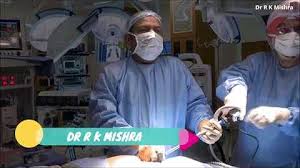Robotic Sleeve Gastrectomy and Cholecystectomy Revolutionize Bariatric and Gallbladder Surgery
Add to
Share
1,300 views
Report
2 years ago
Description
Welcome to a fascinating discussion on the topic of "Unlocking New Possibilities: Robotic Sleeve Gastrectomy and Cholecystectomy Revolutionize Bariatric and Gallbladder Surgery." In this insightful discourse, we explore the innovative use of robotic technology in performing sleeve gastrectomy and cholecystectomy procedures, offering patients enhanced outcomes and transforming the landscape of both bariatric and gallbladder surgery. Robotic-assisted surgery has brought about a paradigm shift in the field of minimally invasive procedures, combining the precision and dexterity of robotic systems with the expertise of skilled surgeons. This synergistic approach has opened up new frontiers, particularly in two critical areas: sleeve gastrectomy for weight loss and cholecystectomy for gallbladder disease. Robotic Sleeve Gastrectomy: Sleeve gastrectomy, a popular weight loss surgery, involves the removal of a portion of the stomach to create a smaller, tube-like sleeve. The advent of robotic technology has revolutionized this procedure by providing surgeons with enhanced visualization, increased range of motion, and precise control during surgery. Robotic sleeve gastrectomy offers several advantages, including smaller incisions, reduced scarring, faster recovery, and improved outcomes in terms of excess weight loss and resolution of obesity-related conditions. This transformative approach empowers patients to achieve their weight loss goals and improve their overall health and quality of life. Robotic Cholecystectomy: Cholecystectomy, the surgical removal of the gallbladder, is commonly performed to treat gallstones and gallbladder-related conditions. Robotic-assisted cholecystectomy has redefined the standard of care in gallbladder surgery. By leveraging robotic technology, surgeons can access the gallbladder with enhanced precision, maneuverability, and three-dimensional visualization. This leads to more accurate dissection, reduced risk of injury to surrounding structures, and improved patient outcomes. Robotic cholecystectomy offers patients the benefits of smaller incisions, minimal scarring, faster recovery, and a reduced risk of complications. The integration of robotic technology in sleeve gastrectomy and cholecystectomy procedures has transformed the surgical experience for both patients and surgeons. The advanced capabilities of robotic systems enable surgeons to perform complex procedures with enhanced precision, resulting in improved patient outcomes and satisfaction. It is important to note that while robotic-assisted surgery offers numerous advantages, the decision to undergo these procedures should be made in consultation with a knowledgeable healthcare team. Each patient's unique condition and medical history should be carefully evaluated to determine the most appropriate treatment approach. In conclusion, the utilization of robotic technology in sleeve gastrectomy and cholecystectomy has unlocked new possibilities and revolutionized bariatric and gallbladder surgery. Robotic-assisted procedures offer patients the advantages of smaller incisions, faster recovery, improved outcomes, and reduced risk of complications. These transformative techniques provide individuals with an opportunity to embark on their weight loss journey or alleviate gallbladder-related issues with increased confidence, knowing that they are benefiting from the cutting-edge advancements in robotic surgery. Introduction: The realm of bariatric and gallbladder surgery has been revolutionized by the advent of robotic technology. This comprehensive discussion explores the transformative impact of robotic-assisted procedures, specifically focusing on sleeve gastrectomy for weight loss and cholecystectomy for gallbladder disease. By unraveling the advancements and benefits brought about by robotic sleeve gastrectomy and cholecystectomy, we delve into the exciting possibilities and improved outcomes in these fields. Sleeve gastrectomy, a widely recognized weight loss surgery, involves removing a portion of the stomach to create a smaller sleeve. Robotic technology has redefined this procedure, providing surgeons with enhanced visualization, precise instrument control, and increased maneuverability. Robotic sleeve gastrectomy boasts numerous advantages, including smaller incisions, reduced scarring, shorter hospital stays, faster recovery, and improved excess weight loss outcomes. This innovative approach empowers patients to achieve sustainable weight loss and enjoy a higher quality of life. Cholecystectomy, the surgical removal of the gallbladder, is a common procedure performed for gallstone-related conditions. Robotic-assisted cholecystectomy has transformed the landscape of gallbladder surgery, offering improved precision and outcomes. The robotic platform facilitates high-definition visualization, greater instrument articulation, and enhanced dexterity. Surgeons can navigate complex anatomical structures with increased accuracy, leading to reduced complications, shorter operative times, and faster patient recovery. Robotic cholecystectomy also presents the advantages of smaller incisions, minimal scarring, and reduced postoperative discomfort, allowing patients to resume their daily activities swiftly. Robotic-assisted sleeve gastrectomy and cholecystectomy offer several notable benefits. The precision and maneuverability of robotic systems enable surgeons to perform meticulous procedures, reducing the risk of complications and ensuring patient safety. The minimally invasive nature of these procedures, with smaller incisions and decreased tissue trauma, results in faster healing, shorter hospital stays, and improved cosmetic outcomes. Additionally, the three-dimensional visualization provided by the robotic platform enhances surgical accuracy and anatomical identification, improving outcomes and patient satisfaction. Surgeons also benefit from improved ergonomics and reduced fatigue, optimizing their performance in the operating room. It is important to emphasize that the decision to undergo robotic sleeve gastrectomy or cholecystectomy should be made collaboratively between patients and their healthcare team, considering individual patient factors, surgeon expertise, and available resources. While robotic-assisted surgery has revolutionized the field, it is not the sole approach and may not be suitable for every patient. In conclusion, the integration of robotic technology in sleeve gastrectomy and cholecystectomy has expanded the horizons of bariatric and gallbladder surgery. Robotic-assisted procedures offer precise surgical techniques, smaller incisions, faster recovery, and improved patient outcomes. These advancements empower patients to embark on their weight loss journey and overcome gallbladder-related issues with confidence. As the field continues to evolve, robotic-assisted surgery opens new frontiers, promising further enhancements and improved patient care.
Similar Videos






